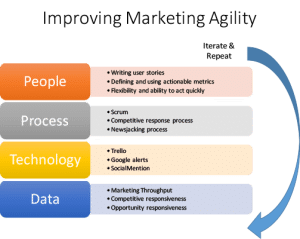Last week I had the opportunity to interview Melanie Darienzo, VP of Client Services with Intelligent Demand, a Denver demand generation and digital marketing agency. Melanie has been practicing Agile Marketing for several years, and I thought I’d catch up with her and talk about how they use Agile, how practicing Agile Marketing is different in an agency (compared to practicing Agile as a brand marketer inside a company) and what tools they use to manage Agile Marketing. I think you’ll enjoy Melanie’s insights.
Transcript Follows
Jim: Hi, this is Jim Ewel and I have Melanie Darienzo from Intelligent Demand where she is the VP of Client Services. Welcome, Melanie.
Melanie: Thank you. Thank you so much for having me, Jim.
Jim: Well, I’m excited to hear a little bit more about what you’re doing there at Intelligent Demand. You’ve been doing some Agile Marketing for a little bit of time. Can you tell me a little bit about how you got started with Agile Marketing?
Melanie: Sure, sure, I’d be happy to. We, at Intelligent Demand, we’re an integrated demand generation marketing agency. So Agile Marketing actually came very naturally to us. It fits perfectly and organically with the agile marketing mindset in that it’s very focused on transparency and results and small bets over the kind of big campaign implementations that you see from other agencies. It wasn’t so much as a getting started as it was just the way it’s always been here at our agency.
Jim: Well tell me a little bit about practicing agile marketing in an agency as opposed to being a brand guy practicing agile marketing. How do you think agile marketing is different for agencies?
Melanie: For agencies, we have some unique challenges because we are bringing this methodology and these set of best practices into an established structure with their own processes and their own decision making and project management processes. So really the way that we have been able to be successful bringing this to our clients is to really show up very quickly with some results and really kind of work backwards with this is the program that we used and the agile marketing mindset that we used to achieve these results and once we can demonstrate those results inside the organization, we very quickly get buy-in and folks are onboard very quickly.
Jim: So if I understand you correctly, you don’t go in and say I’m going to try to sell agile marketing, you instead go in and you’re using agile marketing internally, but then you’re producing the results and you say to the client, okay, here’s what we did and by the way, here’s how we did it. And they either care about that or they don’t care; they only care about the results. Is that right?
Melanie: Yes, that’s exactly right. We’re looking at the results and really what our clients are interested in is time-to-market and time-to-value. So when we can come in and show that we’re taking a strategic view, a long view over 12 or 18 months but we’re able to execute very quickly in a matter of days and weeks versus months and quarters, that’s really how we start to enter in to the conversation around what is Agile Marketing and how exactly are you doing this behind the scenes?
Jim: Okay. What tools do you use in terms of your own practice of Agile Marketing? Do you guys use software tools, do you use white boards, what do you use?
Melanie: It’s a combination of software and white boards. I can tell you that in front of me is a floor-to-ceiling, wall-to-wall whiteboard, so we’re big fans of just putting it on the wall and working through it very quickly with the entire team including our clients. But we also use a piece of software called Trello to track progress for specific stories and cards. We’re definitely not Agile purists. There aren’t that many out there in Agile Marketing. We adjust. We do produce traditional project plans and Gantt charts, but only for the major milestones because we find that is one key piece that our clients are very used to seeing and familiar with, so we weave Agile Marketing and our Sprint process into those Gantt charts. But again, they’re only very high level.
Jim: Okay. What issues have you run into? As you think about your practice of doing Agile Marketing, you said you’re not a purist about it. You mentioned having to produce more traditional project management, Gantt charts and other things; what other things have you run into as you’ve practiced Agile Marketing that you might want to share with people?
Melanie: Sure, there is certainly the need to overcome the established decision making and consensus building processes that are generally in place with our enterprise level clients. It’s not that we suggest, we would never recommend just completely hacking the system or doing something clandestine. That’s definitely not what we would recommend. But we do have to break through some of the traditional mindset of multiple points of sign off and review and things like that and really support our clients and our internal champions to go ahead and take a few small risks and be OK with the fact that we’re going to take some small, calculated, informed chances. They’re not all going to work out. We’re going to learn that one channel may be better than another; one tactic may be better than another. That’s OK and that’s to be learned from.
Jim: Right. That’s an interesting topic because that whole concept of not fearing failure and being allowed to fail is an important part of Agile Marketing, right? And that whole experimentation thing and that when you do an experiment, you find out something worked or didn’t work. It’s not necessarily bad to find out that it didn’t work because you move on.
Melanie: Sure.
Jim: Talk a little bit about that; what’s your thought about that and your experience?
Melanie: Our experience has been that our clients actually find it very refreshing when we start to engage with them. We’re very clear up front that this is our approach and this is how we’re going to launch new campaigns into market and continually analyze through the data, the hard data that doesn’t lie, continually optimize the campaign. Our clients have told us that they find it very refreshing to hear that, versus some other traditional agencies come in and promise the world, and say that we’re going to make some big bets and they’re absolutely going to work because they’ve worked in the past and they’ve worked for our other clients. And that’s something that’s real and it’s tangible and our clients actually appreciate it. Their mindset is set up to understand failure, the word failure, is not a bad word because a particular tactic may not have been the home run that we thought it might be or produce what we thought it might in terms of revenue or leads. That learning that happens in both the development and execution, and the feedback that we get from the marketplace can be applied to other channels, other tactics, other strategies moving forward, so even though that particular one was a “failure”, the learnings are still applied to the overall campaign.
Jim: That’s great. That’s great. One of the other things that Agile Marketing advocates is this whole idea of measurement. Data over opinions and that sort of thing. Talk to me a little bit about that in terms of what you’ve implemented and what you’ve found in terms of working with clients. How do they react to this whole thing of measurement and transparency and all of that business?
Melanie: They really, really appreciate the dashboards and analytics that we’re able to provide to them. As we continue to see the increase of pressure for marketing to demonstrate and justify its contribution to the sales and revenue goals, you can’t do that, you can’t prove efficacy without the data and analytics. Being armed with information and the true data is absolutely critical. The news yesterday about Oracle buying Eloqua – the merger of marketing automation and big data is absolutely at the forefront of everyone’s mind.
Jim: I think so. Melanie, this has been very helpful. I really appreciate your time. I’m sure our listeners will as well. Any last minute pieces of advice or thoughts to people practicing Agile Marketing?
Melanie: Thank you. I really enjoyed talking with you and my advice is follow the data; listen to what it’s telling you.
Jim: Great. Thanks, Melanie.
Melanie: Thanks, Jim.




Jim, Melanie
Watched this video this morning. Very interesting. I was hoping Jim would ask Melanie about the Sales message. It strikes me that other agencies make big promises about results based on previous work. Granted Melanie talks about results but a key part of the message is that they will experiment and learn as part of their approach (even without explicitly mentioning Agile Marketing she must set expectations on how they do the work). How do potential Clients react to that message? Does she find that they lose potential clients – but maybe they are better off without the customer who wants guaranteed results and will not countenance failure.
regards
donncha
Hi Donncha,
Great question. I’m glad you raised this important topic.
You are correct that an effective Agile Marketing agency must be transparent with the methodology during the Sales discussion, as that’s how the results will be delivered.
To familiarize and gain buy-in for the methodology at this early/mid stage, we feel it’s critical to demonstrate that the “experimentation” that is germane to the Agile approach is *deeply* rooted in demand gen best practices, and that each of marketing campaigns (and the iterative testing and evolution) is pursuant to our client overarching strategy and revenue goals.
With that backdrop, we’ve found that potential clients are more willing to hear the Agile Marketing approach and give it a try with us guiding, educating and steering along the way.
Hope that helps. Here’s another blog that expands on the topic: https://intelligentdemand.com/demand-generation/agile-marketing-better-results/
Thanks again for raising the question. Great one!
Melanie